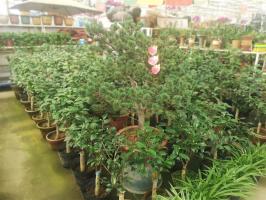Can You Cover the Soil of a Potted Plant?
When it comes to potted plants, one common question that many people ask is whether it is necessary to cover the soil with something. There are different reasons why someone might consider this option, but the answer isn't always that straightforward. Here are a few points to consider before making your decision.
Why Do People Cover the Soil?
One reason why people consider covering the soil of a potted plant is for aesthetic reasons. If the top layer of soil is visible and doesn't look that great, you may want to hide it with a layer of something else. This could be anything from small pebbles to moss, but the main idea is to create a more attractive look for your plant. Another reason why people cover the soil is to help retain moisture. Certain materials, such as mulch, can help keep the soil moist for longer periods, which is beneficial for plants that require a lot of water. Finally, some plant owners cover the soil to help prevent weeds from growing. Depending on the type of coverage, it may be more difficult for weed seeds to take root and spread throughout the pot.
When Should You Cover the Soil?
Whether or not you should cover the soil of your potted plant largely depends on the type of plant and its specific needs. For example, if you have a succulent or cactus, they prefer dry soil, so it would not be wise to cover the soil with materials that help retain moisture. On the other hand, if you have a plant that needs a lot of water, covering the soil with a material that retains moisture can be beneficial. Additionally, if you are dealing with an issue with weeds in your pot, covering the top layer of soil with a material that makes it harder for them to grow may be a good idea.
What Are Some Materials You Can Use to Cover the Soil?
If you've decided to cover the soil of your potted plant, there are several different materials you can choose from. Here are a few options:
Mulch: Organic mulch, such as shredded leaves or bark, can help conserve moisture and prevent weeds.
Moss: Live or preserved moss can create an attractive and natural look for your plant while also helping retain moisture.
Pebbles or stones: These can be placed on top of the soil to create a decorative layer that can also help retain moisture if they are sized large enough to allow water to go through.
Stones: Decorative stones in different colors and textures can give your plant an elegant look, just as much as hide the soil.
How Do You Apply the Covering Material?
The process of applying a cover to the soil of your potted plant is relatively simple. First, make sure the soil is moist enough that it can be compressed easily. Next, sprinkle or place the covering evenly on top of the soil. If you're using a material that retains moisture, be careful not to use too much, as this could lead to problems with overwatering. Finally, gently pat down the covering to create an even layer that will remain in place. Be careful not to compress it too much, as this could prevent air and water from getting in.
Wrapping Up
Overall, whether to cover the soil of a potted plant or not depends largely on the type of plant and its needs. If you decide to cover the top layer of soil, make sure to choose a material that suits your plant's needs and gives an aesthetic appeal to it. Now that you have some idea of the different options available, you can decide whether soil covering is something you want to try for your potted plants.

 how many times do yo...
how many times do yo... how many planted tre...
how many planted tre... how many pine trees ...
how many pine trees ... how many pecan trees...
how many pecan trees... how many plants comp...
how many plants comp... how many plants can ...
how many plants can ... how many plants and ...
how many plants and ... how many pepper plan...
how many pepper plan...
































